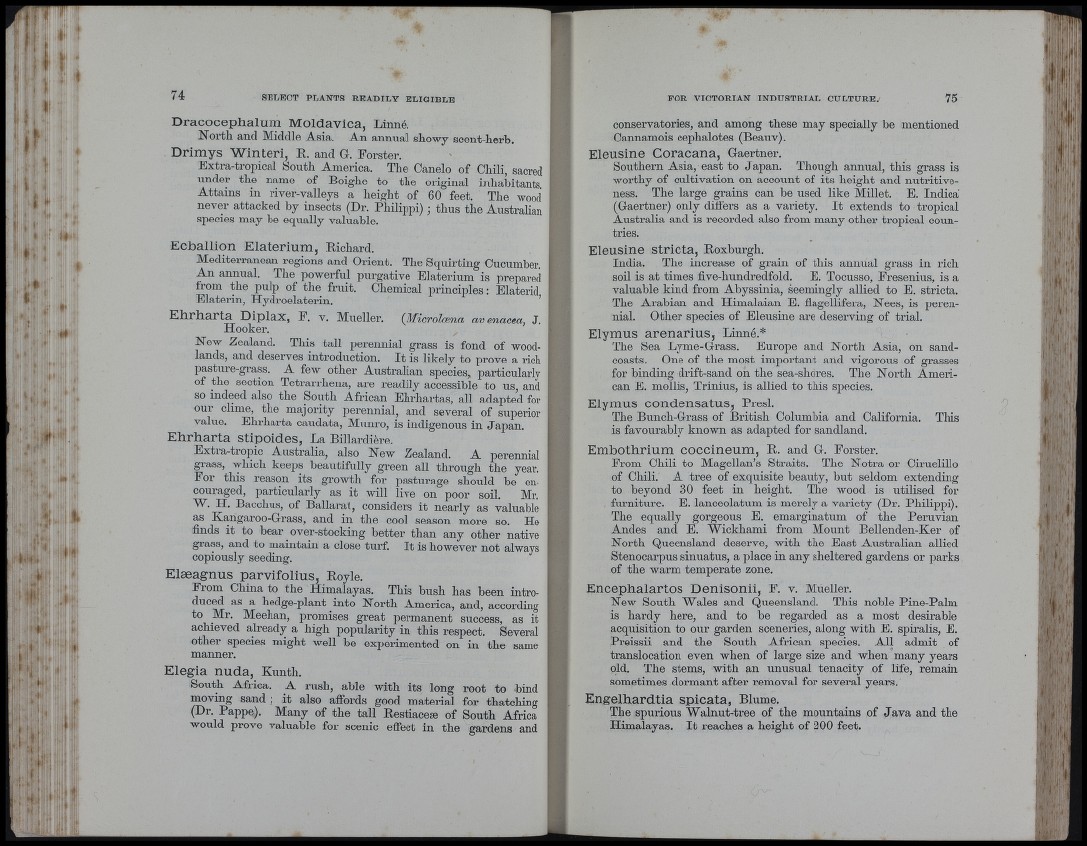
W
i [
,! ",
.M
’ It
Î.
' dll
■HI '
Dracocephalum Moldávica, Linné.
North and Middle Asia. An annual showy scent-herb.
Drimys Winter!, E. and G. Forster.
Extra-tropical South America. The Canelo of Chili, sacred
under the name of Boighe to the original inhabitants.
Attains m river-valleys a height of 60 feet. The wood
never attacked by insects (Dr. Philippi) ; thus the Australian
species may be equally valuable.
Ecballion Elaterium, Eichard.
Mediterranean regions and Orient. The Squirting Cucumber.
An annual. The powerful purgative Elaterium is prepared
from the pulp of the fruit. Chemical principles : Elaterid
Elaterin, Hydroelaterin. ’
E h r h a r t a D ip la x , F. v. Mueller. {Microlcena avenacea, J,
Hooker.
New Zealand. This tall perennial grass is fond of woodlands,
and deserves introduction. I t is likely to prove a rich
pasture-grass. A few other Australian species, particularly
of the section Tetrarrhena, are readily accessible to us, and
so indeed also the South African Ehrhartas, all adapted for
our clime, the majority perennial, and several of superior
value. Ehrharta caudata, Munro, is indigenous in Japan.
Ehrharta stipoides, La Biliardière.
Extra-tropic Australia, also New Zealand. A perennial
grass, which keeps beautifully green all tbrongb the year.
For this reason its growth for pasturage should be encouraged,
particularly as it will live on poor soil. Mr.
W. H. Bacchus, of Ballarat, considers it nearly as valuable
as Kangaroo-Grass, and in the cool season more so. He
finds it to bear over-stocking better than any other native
grass, and to maintain a close turf. I t is however not always
copiously seeding.
Elæagnus parvifolius, Eoyle.
From China to the Himalayas. This bush has been introduced
as a hedge-plant into North America, and, according
to Mr. Meehan, promises great permanent success, as it
achieved already a high popularity in this respect. Several
other species might well be experimented on in the same
manner.
Elegìa nuda, Kunth.
South Africa. A rush, able with its long root to bind
moving sand ; it also afibrds good material for thatching
(Dr. Pappe). Many of the tall Pestiaceæ of South Africa
would prove valuable for scenic effect in the gardens and
conservatories, and among these may specially he mentioned
Cannamois cephalotes (Beauv).
E le u s in e Coracana, Gaertner.
Southern Asia, east to Japan. Though annual, this grass is
worthy of cultivation on account of its height and nutritiveness.
The large grains can be used like Millet. E. Indica
(Gaertner) only differs as a variety. I t extends to tropical
Australia and is recorded also from many other tropical countries.
♦
E leu s in e s t r ic ta , Eoxburgh.
India. The increase of grain of this annual grass in rich
soil is at times five-hundredfold. E. Tocusso, Eresenins, is a
valuable kind from Abyssinia, seemingly allied to E. stricta.
The Arabian and Himalaian E. fiagellifera, Nees, is perennial.
Other species of Eleusine are deserving of trial.
Elymus arenarius, Linné.*
The Sea Lyme-Grass. Europe and North Asia, on sand-
coasts. One of the most important and vigorous of grasses
for binding drift-sand on the sea-shores. The North American
E. mollis, Trinius, is allied to this species.
Elymus condensatus, Presl.
The Bunch-Grass of British Columbia and California. This
is favourably known as adapted for sandland.
Embothrium coccineum, E. and G. Forster.
From Chili to Magellan’s Straits. The Notra or Ciruelillo
of Chili. A tree of exquisite beauty, but seldom extending
to beyond 30 feet in height. The wood is utilised for
furniture. E. lanceolatum is merely a variety (Dr. Philippi).
Tbe equally gorgeous E. emarginatum of the Peruvian
Andes and E. Wickhami from Mount Bellenden-Ker of
North Queensland deserve, with the East Australian allied
Stenocarpus sinuatus, a place in any sheltered gardens or parks
of the warm temperate zone.
Encepbalartos Denisonii, E. v. Mueller.
New South Wales and Queensland. This noble Pine-Palm
is hardy here, and to be regarded as a most desirable
acquisition to our garden sceneries, along with E. spiralis, E.
Preissii and the South African species. All admit of
translocation even when of large size and when many years
old. The stems, with an unusual tenacity of life, remain
sometimes dormant after removal for several years.
Engelhardtia spicata, Blume.
The spurious Walnut-tree of the mountains of Java and the
Himalayas. I t reaches a height of 200 feet.
* If